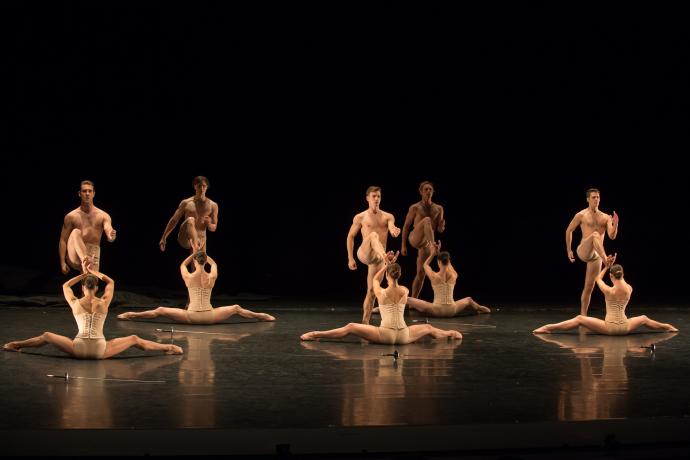|
Washington Ballet in Jiri Kylian's hypnotic "Petite Mort" It’s only been a year, but one can already see the influence Julie Kent has had on the Washington Ballet. This fine company, now in its 72nd year, has attractive dancers, excellent choreography, and likely thanks to the inimitable Kent, a solid feel – one that could take it from regional ensemble to one of the more important ballet institutions in our country.
It would be fitting as it does represent our nation’s Capitol. And it is representing it well as the finale to the Jacob’s Pillow season. The 30-member company is offering a knockout program of three works Jiri Kylian’s mesmerizing “Petite Mort,” Alexei Ratmansky’s delicious “Seven Sonatas” and Annabelle Lopez Ochoa’s playful “Sombrerisimo.” Kylian’s work instantly takes in its viewers with its tableau – six men balancing swords on their fingers and six women, motionless and lurking in the dark background, in black, baroque-style gowns. Mozart’s Piano Concerto in A Major KV 488 awakens the men. They swipe their blades through the air, swing them around their feet and necks like a majorette toying with her baton. Danger hang heavy in the air. And then in a flash, they grab a stage-size cloth that obscures the scene. As they draw it back, the women are out of their dresses, the swords are gone and a series of formal but unexpected pas de deux unfold. Kylian transports his audience to another dimension – a place where men and women, wearing now corset-like costumes, are clear in their social roles, but willing to break with the norm. All of the duets are hypnotic, but Brooklyn Mack and Ayano Kimura are especially alluring. Their connection is real and therefore lending their dance an authenticity that capture every eye in the audience. And this is where the influence of Kent, who danced every dramatic heroine and classical role in American Ballet Theatre’s repertoire, comes in. She was the ideal ballerina, what a prima is suppose to be all about. She was not just a dancer who could perform tricks, but one who infused meaning into her steps. And she is sharing this knowledge, ingrained in the fibers of her body and soul, with her dancers. The dancers demonstrate their cohesiveness once again in “Seven Sonatas,” a series of Russian-inspired dances to music, played live, by Scarlatti. With pianist Glenn Sales onstage, the dancers gambol with counterpoint and solos and duets that are joyful and windswept. Gian Carlo Perez and Sona Kharatian duet is the exception. Ardent and tender, it is the beautiful, romantic heart of “Seven Sonatas.” The evening ends with the boisterous “Sombrerisimo,” an all-male dance that allows the guys to cut loose and show a less serious side to the company’s persona. With six men and six bowler hats, the dance tickles with high-flying moves that add up to a delightful diversion. Lastly, there is one more reason to love Washington Ballet. They have dancers of color – something I’d love to see more ensemble strive for.
0 Comments
Beatrice Capote, left, and Chloe Davis are two pals whose friendship deteriorates in "BLACK GIRL: Linguistic Play." The idea of seeing Camille A. Brown’s “BLACK GIRL: Linguistic Play” excited me. I thought here will be a work that will explore what it is like to be a black girl in America. It will enlighten with a point of view of the neglected black, female child. And it will apprise its viewer on racism, which too many believe no longer exists.
But if you enter with high expectation, you often leave disappointed. That’s what happened on Thursday night at Jacob’s Pillow where Brown staged her evening-length work with her Camille A. Brown and Dancers. While all the moving parts – the music, the sets and the dancers were outstanding, “BLACK GIRL” didn’t inform or uplift its audience. It just was simply an extended mime of girlish games – jump rope, hopscotch and patty cake for an hour. And while the bluesy bass played by Robin Bramlett and piano played by Scott Patterson added tone and color, the dance left one void of any sympathy or feeling for these girls – an essential ingredient to engaging one’s soul and psyche, which is the reason for art. It begins with Brown herself stomping and dancing in an extensive solo. She grooves on the musical rhythms with her feet and her hands. Jumping to and from raised platforms, there was an expectation that her dance would build. But it stayed in place as she skipped and sprung and made a lot of gestures – fist pounding her chest in a gesture of love or swinging her head around with attitude. She was finally joined by Catherine Foster. The two played out a duet that started with fancy footwork derived from double Dutch jump roping and it grew into a foot pounding, hand-clapping battle into which the two were perfectly synchronized. Here is where you see the skill involved in Brown’s work, but some how the visual and aural sport didn’t add up to anything that could touch the human heart. The closest that came was a duet between Bernice Capote and Chloe Davis. The friendship between these two was destroyed as Davis sought to outshine Capote. The latter crumpled into a heap, destroyed by Davis’ dismissal of her for her own personal gains. Here was a story that all could relate to. The final section with Brown and Teneise Ellis was baffling. Brown looked to be braiding Ellis’ hair, but Ellis ducked time and again from Brown, flopping about in ways that were baffling. The incomprehensible movement and relationship further complicated an appreciation for “Linguistic Play.” Applause must be given to Elizabeth Nelson for her colorful chalkboard set. It lent this labored dance an urban and multicolor flare that was gloriously welcome. |
Wendy
|


 RSS Feed
RSS Feed
